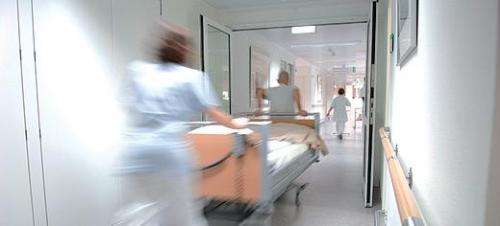Superbugs spread through the air in hospital wards

(Medical Xpress)—Hospital superbugs can float on air currents and contaminate surfaces far from infected patients' beds, according to University of Leeds researchers.
The results of the study, which was funded by the Engineering and Physical Sciences Research Council (EPSRC), may explain why, despite strict cleaning regimes and hygiene controls, some hospitals still struggle to prevent bacteria moving from patient to patient.
It is already recognised that hospital superbugs, such as MRSA and C-difficile, can be spread through contact. Patients, visitors or even hospital staff can inadvertently touch surfaces contaminated with bacteria and then pass the infection on to others, resulting in a great stress in hospitals on keeping hands and surfaces clean.
But the University of Leeds research showed that coughing, sneezing or simply shaking the bedclothes can send superbugs into flight, allowing them to contaminate recently-cleaned surfaces.
PhD student Marco-Felipe King used a biological aerosol chamber, one of a handful in the world, to replicate conditions in one- and two-bedded hospital rooms. He released tiny aerosol droplets containing Staphyloccus aureus, a bacteria related to MRSA, from a heated mannequin simulating the heat emitted by a human body. He placed open Petri dishes where other patients' beds, bedside tables, chairs and washbasins might be and then checked where the bacteria landed and grew.
The results confirmed that contamination can spread to surfaces across a ward. "The level of contamination immediately around the patient's bed was high but you would expect that. Hospitals keep beds clean and disinfect the tables and surfaces next to beds," said Dr Cath Noakes, from the University's School of Civil Engineering, who supervised the work. "However, we also captured significant quantities of bacteria right across the room, up to 3.5 metres away and especially along the route of the airflows in the room."
"We now need to find out whether this airborne dispersion is an important route of spreading infection," added co-supervisor Dr Andy Sleigh.
The researchers are hoping that computer modelling will help them determine the risk. The findings have been compared to airflow simulations of the mock-up hospital rooms and the research team have shown that they are able to accurately predict how airborne particles can be deposited on surfaces.
"Using our understanding of airflow dynamics, we can now use these models to investigate how different ward layouts and different positions of windows, doors and air vents could help prevent microorganisms being deposited on accessible surfaces," said Mr King.
The international design and engineering firm Arup, which designs hospitals, part sponsored the study.
Phil Nedin, director and global healthcare business leader at Arup, said: "We are looking at healthcare facilities of the future and it is important that we look at key issues such as infection control. Being involved in microbiological studies that inform airflow modelling in potentially infectious environments allows us to get a clear understanding of the risks in these particular environments."
The paper "Bioaerosol Deposition in Single and Two-Bed Hospital Rooms: A Numerical and Experimental Study" is published in the journal Building and Environment.
More information: M.F. King, C.J. Noakes, P.A. Sleigh, M.A. Camargo-Valero, 'Bioaerosol Deposition in Single and Two-Bed Hospital Rooms: A Numerical and Experimental Study' Building and Environment (2012). DOI 10.1016/j.buildenv.2012.09.011













